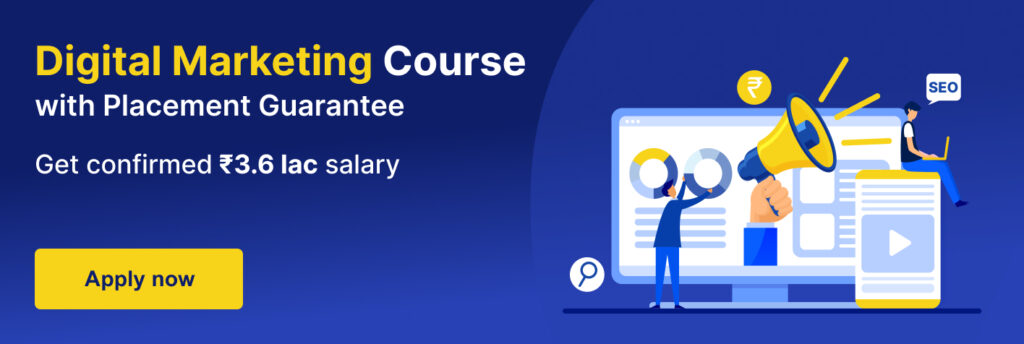SEO Content Writing: Unlocking the Power of Effective Online Communication
Unleashing your content’s potential in the vast digital world demands more than just great writing. To ensure your content reaches its intended audience and ranks well on search engine result pages (SERPs), SEO content writing is essential. In this blog, you will see the key principles and strategies of SEO content writing, providing you with actionable tips and examples to enhance your online visibility and engage your target audience.
What is SEO Content Writing?
SEO content writing involves writing web content that appeals to both search engines and human readers. By optimizing your content for search engines, you increase its visibility, driving organic traffic to your website or blog.
Simultaneously, engaging and informative content keeps your readers hooked, encouraging them to spend more time on your website, reducing bounce rates, and improving the overall user experience. Learn digital marketing to become an SEO master.
Keyword Research and Integration
Effective keyword research and integration play a crucial role in optimizing your content for search engines. Let’s see how you can leverage keywords to enhance your online visibility and engage your target audience.
1. Begin with Keyword Research
Keyword research is a crucial first step in any successful digital marketing strategy. By utilizing the popular tools mentioned below, you can uncover relevant keywords related to your topic.
- Use popular keyword research tools such as Google Keyword Planner, SEMrush, or Moz Keyword Explorer to discover pertinent keywords aligned with your topic.
- Analyze factors such as search volume, keyword competition, and user intent to determine the priority of your target keywords.
2. Incorporate Keywords Effectively
Incorporating keywords effectively is crucial for enhancing the visibility and relevance of your article. Let’s see how we can achieve it:
- Title Optimization: Employ the primary keyword in the title of your article, signaling its relevance and optimizing its visibility to both readers and search engines.
- Strategic Keyword Placement: Emphasize the importance of the primary keyword by including it in the first paragraph and subheadings within your article. This strategic placement reinforces its relevance and improves overall search engine optimization.
- Seamless Keyword Integration: Naturally incorporate relevant secondary keywords throughout your content, ensuring they blend seamlessly with the flow of the article. This approach enhances the depth of keyword optimization while maintaining a reader-friendly experience.
Example: You’re writing an article about healthy breakfast options. Your primary keyword might be “healthy breakfast ideas,” while secondary keywords could include “quick breakfast recipes,” “nutritious morning meals,” or “easy breakfast options.”
Explore the best digital marketing course with placement guarantee to excel in all the concepts of digital marketing.
Structure and Formatting
When it comes to organizing your content effectively, optimizing headings and writing compelling meta descriptions play a vital role. These elements not only enhance readability but also contribute to improving your content’s search engine optimization.
1. Optimize Your Headings
Effective heading optimization plays a crucial role in enhancing the readability, SEO performance, and overall impact of your article. By using these methods, you can create a well-structured and easily navigable blog that resonates with both readers and search engines.
- Optimal Heading Structure: Use the H1 tag for the main title of your article to provide it with an appropriate heading structure and emphasize its significance.
- Organized Content Layout: Structure your content using H2, H3, and other heading tags for subheadings, ensuring a well-organized article layout. This helps readers navigate and comprehend your content more easily.
- SEO-Driven Subheadings: Boost your article’s SEO by strategically incorporating relevant keywords or related phrases into the subheadings. This practice enhances keyword optimization and improves search engine visibility.
2. Write Compelling Meta Descriptions
By using the below methods, you can unlock the true potential of your content with compelling meta descriptions and boost your online visibility.
- Meta descriptions: HTML attributes that offer concise content summaries, should be written with relevance in mind. Include pertinent keywords and create unique, captivating descriptions that entice users.
- Optimizing Meta Descriptions: When composing meta descriptions, and HTML attributes summarizing your content, incorporate relevant keywords to enhance visibility. Write distinct and compelling descriptions within the recommended character limit, aiming for conciseness and persuasive appeal.
Example: Meta description for a healthy breakfast ideas article: “Discover 10 mouthwatering and nutritious breakfast ideas to kickstart your day! From quick recipes to wholesome options, find easy breakfast solutions for a healthier lifestyle.”
Content Creation and Optimization
Producing valuable and engaging content is a crucial aspect of SEO content writing. By following these strategies, you can optimize your content to attract readers and improve its performance:
1. Produce Valuable and Engaging Content
By understanding users’ needs and offering fresh insights, we create content that leaves a lasting impact while providing actionable solutions and expert knowledge. And below are methods that can help us archive that:
- Creating Engaging and Valuable Content: Write unique content that stands out from the crowd, offering fresh insights and perspectives. Conduct thorough research to ensure accuracy and credibility. And provide valuable information, actionable tips, or in-depth analysis that helps readers solve problems or gain new knowledge.
- Audience-Centric Content: Understand your target audience’s needs, challenges, and interests. Tailor your content to address specific pain points and offer practical solutions. And anticipate and answer common questions, demonstrating expertise and building trust with your readers.
- Catchy Introductions: Begin with a compelling hook that grabs the reader’s attention. Use storytelling, intriguing facts, or thought-provoking statements to spark interest. And clearly state the purpose or benefit of reading the content, setting the stage for what’s to come.
2. Optimize Content-Length
Optimizing content length is crucial for better search engine rankings and reader engagement. And the below methods ensure maximum impact on the users:
- Long-form content: In search engine rankings, long-form content generally outperforms shorter pieces. Strive to create comprehensive articles with a minimum word count of 1,000, allowing for in-depth coverage of the topic. Focus on maintaining engagement and a well-structured format throughout the content.
- Engaging Readers: By diving into the topic extensively, you provide comprehensive coverage that appeals to both search engines and readers. Remember to write engaging content and maintain a well-structured format to maximize its impact.
3. Use Multimedia Elements
In today’s digital landscape, incorporating multimedia elements has become crucial for enhancing user experience and engagement. Let’s look at them:
- User Experience: Elevate the user experience by incorporating visually appealing elements such as relevant images, infographics, videos, and charts into your content. These multimedia components enhance engagement and understanding.
- Optimizing User Engagement: Improve user engagement by integrating relevant images, infographics, videos, and charts that complement your content. Optimize these multimedia elements with descriptive alt text and appropriate file names to enhance accessibility and search engine optimization (SEO).
Example: In an article about healthy breakfast ideas, you can include step-by-step images of preparing a nutritious smoothie or a visually appealing infographic showcasing different breakfast options.


On-Page SEO Factors
In addition to creating high-quality content, optimizing various on-page elements is crucial to improve your website’s search engine rankings. Here are some important on-page SEO factors to consider:
1. URL Optimization
URL optimization is a crucial aspect of search engine optimization (SEO) that involves the methods listed below:
- To optimize your URLs ensure they are concise, descriptive, and contain relevant keywords.
- Using tools like hyphens to separate words can enhance readability and improve the overall SEO value of your website.
Example: www.yourwebsite.com/healthy-breakfast-ideas
2. Internal and External Linking
Internal and external linking are crucial aspects of website optimization and content credibility, let’s look at the below methods:
- Improving User Experience: Enhance the user experience and engagement on your website by incorporating relevant internal links that guide readers to other valuable content. By strategically interlinking your web pages, you can help readers discover more information within your website.
- Building Credible Content: Strengthen the credibility and depth of your content by including authoritative external links to reputable sources. Support your claims and provide additional information by linking to trusted websites, enhancing the overall reliability and value of your content.
3. Optimize Images
Optimizing images is crucial for enhancing website performance and user experience. Here’s how you can do that:
- Efficient Compression Technique: Compress images for faster page load times, and reduce file sizes without compromising quality using compression tools, ensuring an efficient browsing experience for visitors.
- Utilizing Alt Text: Add relevant alt text, and describe images with concise and keyword-rich alt text, benefiting visually impaired users and enhancing SEO for search engine understanding.
User Experience and Engagement
To attract your audience and keep them engaged, it is crucial to prioritize user experience and encourage interaction with your content.
1. Enhance Readability
Improving the readability of your content is crucial for engaging and retaining your readers. By implementing the techniques below, you can create a visually appealing and reader-friendly experience.
- Enhancing Readability: Use subheadings, bullet points, and short paragraphs to break down your text into manageable chunks. This helps readers navigate the content more effectively.
- Optimizing Text Legibility: Opt for fonts that are easy on the eyes and ensure the text is large enough to be comfortably read across different devices.
- Visual Balance and Clarity: Incorporate white space throughout your content. White space, or space, helps create a sense of visual balance and prevents the text from appearing cluttered or overwhelming.
2. Encourage Social Sharing
In today’s digital age, encouraging social sharing is paramount to increasing content visibility and user engagement. They help in:
- Driving User Engagement: Write compelling CTA statements, and encourage readers to take action by sharing your content or leaving comments. Use persuasive language and incentives to motivate them to engage with your content actively.
Conclusion
SEO content writing is a vital skill for content creators and marketers seeking to increase their online visibility, drive organic traffic, and engage their target audience. By implementing effective keyword research, optimizing content structure and formatting, and focusing on user experience, you can create content that ranks well on search engine result pages while providing value to your readers.







